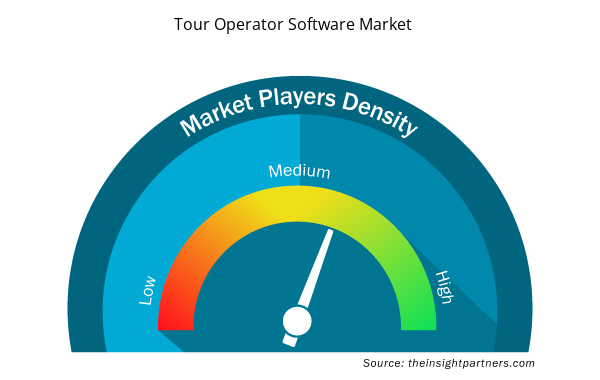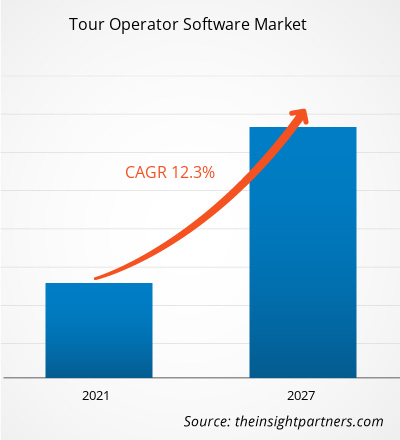ツアーオペレーターソフトウェア市場は、2020年の5億7,425万米ドルから2027年までに1億2,9507万米ドルに成長すると予想されており、2020年から2027年にかけて12.3%のCAGRで成長すると予測されています。
経済見通しが明るい中で世界的に観光産業が成長していることが、市場の成長につながっています。観光部門の成長は、GDP成長、経済規模、旅行インフラの整備、産業構成、人口、規制政策などの要因によって左右されます。これらの要因は国によって異なり、その国への旅行投資に影響を与えます。観光産業は長年にわたって驚異的な成長を遂げ、着実に増加しています。社会のあらゆる階層における観光需要により、道路観光、水路観光、航空観光など、さまざまな種類の観光が生まれ、その中でも道路観光が長い間業界を支配してきました。先進国と発展途上国の大衆の可処分所得が増加したことにより、魅力的なオファーを選択してツアーを予約するツアーオペレーターの採用が増えています。さらに、中国やインドなどの発展途上国のGDP成長により、今後数年間の市場成長に十分な機会が提供されると予想されています。世界経済の明るい見通し、旅行インフラへの投資、中小企業の成長、国境を越えた貿易量の増大、そして政治情勢の安定化により、今後数年間で世界中で観光への支出が増加すると予想されています。グローバル化と国境を越えた貿易の増加に伴い、観光への支出も増加しています。これらの要因は、ツアーオペレーターソフトウェア市場の成長にプラスの影響を与えています。
要件に合わせてレポートをカスタマイズする
このレポートの一部、国レベルの分析、Excelデータパックなど、あらゆるレポートを無料でカスタマイズできます。また、スタートアップや大学向けのお得なオファーや割引もご利用いただけます。
- このレポートの主要な市場動向を入手してください。この無料サンプルには、市場動向から見積もりや予測に至るまでのデータ分析が含まれます。
COVID-19パンデミックがツアーオペレーターソフトウェア市場に与える影響
コロナウイルス(COVID-19)の出現と急速な拡大により、先進国だけでなく発展途上国を含む多くの国が麻痺状態に陥っています。感染者数の継続的な増加は、世界中のいくつかの産業を脅かしています。2020年12月現在、確認された症例と報告された死亡者数で最も影響を受けている国には、米国、インド、ブラジル、ロシア、フランスなどがあります。コロナウイルスの発生は、ロックダウン、渡航禁止、事業停止により、さまざまな国の経済と産業に影響を及ぼしています。ほとんどの国がロックダウンを実施しているため、旅行と観光部門に悪影響を及ぼしています。さまざまな地域の政府による国内および国際旅行の一時的な制限も、観光部門のマイナス傾向を示しています。COVID-19の継続的な拡散は、ツアーオペレーターソフトウェア市場のプレーヤーにとって非常に危険です。
市場洞察 - ツアーオペレーターソフトウェア市場
観光業界におけるAI導入の増加
オペレーターを通じて魅力的なツアーパッケージを予約するプロセス全体を強化するために人工知能(AI)の統合が進み、ツアーオペレーターソフトウェアの採用が進んでいます。観光業界でのAIとロボット工学の採用は、ツアーオペレーターが提供する顧客体験とサービスの向上につながっています。人工知能の導入により、乗客の旅行手配がさらに強化され、期待に応えられるようになります。また、カスタマイズされ、自動化され、洞察力に富んだ優れた旅行サービスも提供されます。AIの統合により、ツアーオペレーターは旅行者の興味や行動を研究し、強化された体験を提供できます。旅行・観光業界のAIは、主に顧客エンゲージメントとサービスに重点を置いており、旅行者の旅行体験をさらに向上させています。観光分野におけるチャットボット、言語翻訳、バーチャルリアリティなどの新興AIテクノロジーは、旅行、観光、ホスピタリティ業界にプラスの影響を与えています。このように、AIの統合の増加は、世界中の観光部門をさらに後押ししています。
コンポーネントベースの洞察
コンポーネントに基づいて、ツアーオペレーターソフトウェア市場はソフトウェア、サービスに分類されます。ソフトウェアセグメントは2019年に最大の市場シェアを占めました。
ツアーオペレーター ソフトウェア市場で活動する企業は、主に高度で効率的な製品の開発に重点を置いています。
- 2020年、GP Solutions GmbHとComBtasは戦略的パートナーシップを確立しました。この提携は、イスラエル市場に存在する顧客を対象としています。このコラボレーションにより、ComBtasはGPトラベルエンタープライズやGPトラベルハブを含むGP Solutionsのターンキー製品を宣伝します。
- 2020年、Travefy, Inc.は旅行アドバイザー向けのウェブサイトビルダーをリリースしました。このウェブサイトビルダーを使用すると、アドバイザーはウェブサイトやマーケティングランディングページを作成できます。このウェブサイトビルダーはドラッグアンドドロップインターフェースを使用しており、アドバイザーはテーマを選択したり、コンテンツをカスタマイズしたり、カスタムURLを使用したりできます。さらに、このツールはサブスクリプションプランに含まれています。
ツアーオペレーターソフトウェア市場の地域別分析
予測期間を通じてツアー オペレーター ソフトウェア市場に影響を与える地域的な傾向と要因は、Insight Partners のアナリストによって徹底的に説明されています。このセクションでは、北米、ヨーロッパ、アジア太平洋、中東、アフリカ、南米、中米にわたるツアー オペレーター ソフトウェア市場のセグメントと地理についても説明します。

- ツアーオペレーターソフトウェア市場の地域別データを入手
ツアーオペレーターソフトウェア市場レポートの範囲
| レポート属性 | 詳細 |
|---|---|
| 2020年の市場規模 | 5億7,425万米ドル |
| 2027年までの市場規模 | 12億9,507万米ドル |
| 世界のCAGR(2020年 - 2027年) | 12.3% |
| 履歴データ | 2018-2019 |
| 予測期間 | 2021-2027 |
| 対象セグメント | コンポーネント別
|
| 対象地域と国 | 北米
|
| 市場リーダーと主要企業プロフィール |
|
ツアーオペレーターソフトウェア市場のプレーヤー密度:ビジネスダイナミクスへの影響を理解する
ツアー オペレーター ソフトウェア市場は、消費者の嗜好の変化、技術の進歩、製品の利点に対する認識の高まりなどの要因により、エンド ユーザーの需要が高まり、急速に成長しています。需要が高まるにつれて、企業は提供内容を拡大し、消費者のニーズを満たすために革新し、新たなトレンドを活用し、市場の成長をさらに促進しています。
市場プレーヤー密度とは、特定の市場または業界内で活動している企業または会社の分布を指します。これは、特定の市場スペースに、その市場規模または総市場価値に対してどれだけの競合相手 (市場プレーヤー) が存在するかを示します。
ツアーオペレーターソフトウェア市場で事業を展開している主要企業は次のとおりです。
- チェックフロント株式会社
- GPソリューションズ株式会社
- レズディ
- ツアープラン
- トラベファイ株式会社
免責事項:上記の企業は、特定の順序でランク付けされていません。

- ツアーオペレーターソフトウェア市場のトップキープレーヤーの概要を入手
ツアーオペレーターソフトウェア市場は次のように分類されます。
世界のツアーオペレーターソフトウェア市場 – コンポーネント別
- ソフトウェア
- サービス
世界のツアーオペレーターソフトウェア市場 – 企業規模別
- 大企業
- 中小企業
世界のツアーオペレーターソフトウェア市場 – サブスクリプションタイプ別
- 1回限りのサブスクリプション
- 月額サブスクリプション
- 年間購読
世界のツアーオペレーターソフトウェア市場 – 地域別
北米
- 私たち
- カナダ
- メキシコ
ヨーロッパ
- フランス
- ドイツ
- イタリア
- ロシア
- 英国
- その他のヨーロッパ
アジア太平洋(APAC)
- 日本
- 中国
- オーストラリア
- インド
- 韓国
- その他のアジア太平洋地域
中東およびアフリカ(MEA)
- サウジアラビア
- アラブ首長国連邦
- 南アフリカ
- MEAの残り
南アメリカ(SAM)
- ブラジル
- アルゼンチン
- 残りのSAM
ツアーオペレーターソフトウェア市場 – 企業プロファイル
- チェックフロント株式会社
- GPソリューションズ株式会社
- レズディ
- ツアープラン
- トラベファイ株式会社
- トラベロプロ
- トラウェックステクノロジーズ株式会社
- TrekkSoft (TrekkSoft グループ)
- 株式会社トライトン
- 株式会社ゾラ
- 過去2年間の分析、基準年、CAGRによる予測(7年間)
- PEST分析とSWOT分析
- 市場規模価値/数量 - 世界、地域、国
- 業界と競争環境
- Excel データセット



Report Coverage
Revenue forecast, Company Analysis, Industry landscape, Growth factors, and Trends

Segment Covered
This text is related
to segments covered.

Regional Scope
North America, Europe, Asia Pacific, Middle East & Africa, South & Central America

Country Scope
This text is related
to country scope.
よくある質問
The growth of the tourism sector is influenced by factors such as GDP growth, size of the economy, travel infrastructure development, industry mix, population, and regulatory policies. These factors vary from one country to another and affect the travel investment in that particular country. The tourism industry has spurred stupendously over the years and is at a constant rise. The demand for tourism among every class of society has led to the emergence of various types of tourism, such as roadways tourism, waterways tourism, and aerial tourism, among which roadways tourism has dominated the industry for a long period. Increasing disposable income among the masses in developed as well as developing countries has resulted in rising adoption of tour operators to book their tour by opting fascinating offers, drive the adoption of the tour operator software.
The tour operator software market is led by large enterprise segment with highest share and is expected to dominate in the forecast period. Organizations with more than 50 employees are classified as large enterprises. These enterprises have their clients across several regions as well as account for high market shares, technical knowledge, as well as effective business strategies. These large enterprises invest a significant amount in innovative and latest technologies to operate their business effectively. The benefits conferred by tour operator software for large enterprise are MS texting and live chat for sales, support & ops teams; B2B booking platform for travel agents; and reservation, accounting and marketing for travel agencies.
With the presence of several scenic destinations in the developing economies, there is growth in the tourism sector along with the adoption of tour operator software in these economies. For instance, Nepal is leveraging the tourism sector owing to the presence of Himalayan and Mt. Everest ranges. Nepal tourism offers robust services for Dolpo Trek, Simikot Trek, and to sightsee various hidden valleys in Nepal. Additionally, India’s Goa Tourism Development Corporation (GTDC) announced its plan to have a heli-tours, and the project was commissioned by the Government recently. Therefore, these tourism developments boost the adoption of tour operator software, which facilitates tour operators to offer attractive tour packages to these places. It is anticipated that the introduction of tour operator software will be adding another attraction to the adventure tourism portfolio in the developing economies. This anticipated to offer ample growth opportunities for the global tour operator software market players.
Trends and growth analysis reports related to Technology, Media and Telecommunications : READ MORE..
The List of Companies - Tour Operator Software Market
- Checkfront Inc
- GP Solutions GmbH
- Rezdy
- Tourplan
- Travefy, Inc.
- TraveloPro
- Trawex Technologies Pvt Ltd.
- TrekkSoft (TrekkSoft Group)
- TRYTN, Inc.
- Xola, Inc
The Insight Partners performs research in 4 major stages: Data Collection & Secondary Research, Primary Research, Data Analysis and Data Triangulation & Final Review.
- Data Collection and Secondary Research:
As a market research and consulting firm operating from a decade, we have published and advised several client across the globe. First step for any study will start with an assessment of currently available data and insights from existing reports. Further, historical and current market information is collected from Investor Presentations, Annual Reports, SEC Filings, etc., and other information related to company’s performance and market positioning are gathered from Paid Databases (Factiva, Hoovers, and Reuters) and various other publications available in public domain.
Several associations trade associates, technical forums, institutes, societies and organization are accessed to gain technical as well as market related insights through their publications such as research papers, blogs and press releases related to the studies are referred to get cues about the market. Further, white papers, journals, magazines, and other news articles published in last 3 years are scrutinized and analyzed to understand the current market trends.
- Primary Research:
The primarily interview analysis comprise of data obtained from industry participants interview and answers to survey questions gathered by in-house primary team.
For primary research, interviews are conducted with industry experts/CEOs/Marketing Managers/VPs/Subject Matter Experts from both demand and supply side to get a 360-degree view of the market. The primary team conducts several interviews based on the complexity of the markets to understand the various market trends and dynamics which makes research more credible and precise.
A typical research interview fulfils the following functions:
- Provides first-hand information on the market size, market trends, growth trends, competitive landscape, and outlook
- Validates and strengthens in-house secondary research findings
- Develops the analysis team’s expertise and market understanding
Primary research involves email interactions and telephone interviews for each market, category, segment, and sub-segment across geographies. The participants who typically take part in such a process include, but are not limited to:
- Industry participants: VPs, business development managers, market intelligence managers and national sales managers
- Outside experts: Valuation experts, research analysts and key opinion leaders specializing in the electronics and semiconductor industry.
Below is the breakup of our primary respondents by company, designation, and region:

Once we receive the confirmation from primary research sources or primary respondents, we finalize the base year market estimation and forecast the data as per the macroeconomic and microeconomic factors assessed during data collection.
- Data Analysis:
Once data is validated through both secondary as well as primary respondents, we finalize the market estimations by hypothesis formulation and factor analysis at regional and country level.
- Macro-Economic Factor Analysis:
We analyse macroeconomic indicators such the gross domestic product (GDP), increase in the demand for goods and services across industries, technological advancement, regional economic growth, governmental policies, the influence of COVID-19, PEST analysis, and other aspects. This analysis aids in setting benchmarks for various nations/regions and approximating market splits. Additionally, the general trend of the aforementioned components aid in determining the market's development possibilities.
- Country Level Data:
Various factors that are especially aligned to the country are taken into account to determine the market size for a certain area and country, including the presence of vendors, such as headquarters and offices, the country's GDP, demand patterns, and industry growth. To comprehend the market dynamics for the nation, a number of growth variables, inhibitors, application areas, and current market trends are researched. The aforementioned elements aid in determining the country's overall market's growth potential.
- Company Profile:
The “Table of Contents” is formulated by listing and analyzing more than 25 - 30 companies operating in the market ecosystem across geographies. However, we profile only 10 companies as a standard practice in our syndicate reports. These 10 companies comprise leading, emerging, and regional players. Nonetheless, our analysis is not restricted to the 10 listed companies, we also analyze other companies present in the market to develop a holistic view and understand the prevailing trends. The “Company Profiles” section in the report covers key facts, business description, products & services, financial information, SWOT analysis, and key developments. The financial information presented is extracted from the annual reports and official documents of the publicly listed companies. Upon collecting the information for the sections of respective companies, we verify them via various primary sources and then compile the data in respective company profiles. The company level information helps us in deriving the base number as well as in forecasting the market size.
- Developing Base Number:
Aggregation of sales statistics (2020-2022) and macro-economic factor, and other secondary and primary research insights are utilized to arrive at base number and related market shares for 2022. The data gaps are identified in this step and relevant market data is analyzed, collected from paid primary interviews or databases. On finalizing the base year market size, forecasts are developed on the basis of macro-economic, industry and market growth factors and company level analysis.
- Data Triangulation and Final Review:
The market findings and base year market size calculations are validated from supply as well as demand side. Demand side validations are based on macro-economic factor analysis and benchmarks for respective regions and countries. In case of supply side validations, revenues of major companies are estimated (in case not available) based on industry benchmark, approximate number of employees, product portfolio, and primary interviews revenues are gathered. Further revenue from target product/service segment is assessed to avoid overshooting of market statistics. In case of heavy deviations between supply and demand side values, all thes steps are repeated to achieve synchronization.
We follow an iterative model, wherein we share our research findings with Subject Matter Experts (SME’s) and Key Opinion Leaders (KOLs) until consensus view of the market is not formulated – this model negates any drastic deviation in the opinions of experts. Only validated and universally acceptable research findings are quoted in our reports.
We have important check points that we use to validate our research findings – which we call – data triangulation, where we validate the information, we generate from secondary sources with primary interviews and then we re-validate with our internal data bases and Subject matter experts. This comprehensive model enables us to deliver high quality, reliable data in shortest possible time.


 このレポートの無料サンプルを入手する
このレポートの無料サンプルを入手する